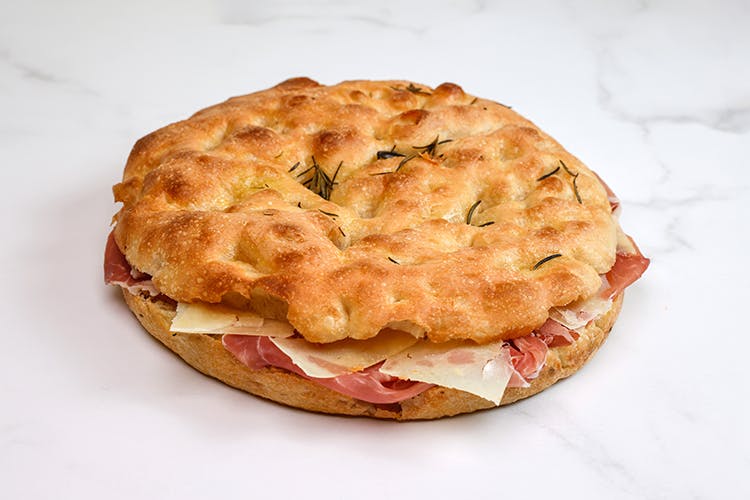Take a taste of Toscana! Prosciutto Toscano DOP and Pecorino Toscano DOP cheese pair perfectly in this brilliantly simple panino layered on fluffy focaccia with sea salt, rosemary and olive oil. The delicate flavors of Prosciutto Toscano DOP and Pecorino Toscano DOP cheese shine when draped between two layers of our housemade focaccia —an Eataly classic. Take the time to prepare our recipe for focaccia following our recipe below — it's worth the effort! — then, add paper-thin slices of Prosciutto Toscano DOP and shavings of Pecorino Toscano DOP cheese to fully celebrate the flavors of the Tuscan region.

Prosciutto Toscano DOP & Shaved Pecorino Toscano DOP on Focaccia Classica with Sea Salt, Rosemary & Olive Oil
Recipe courtesy of Eataly
To make the focaccia:
250 ml water & 100 ml water
Medium Sized Bowl
Lipped 18” x 13” Baking Tray
Plastic Wrap or Kitchen Towels
500 grams Mulino Marino Organic “0” Flour
8 grams Fresh Yeast
50 grams Extra Virgin Olive Oil (for the dough)
15 grams Sea Salt
15 grams Extra Virgin Olive Oil (for pan)
For the Salamoia (Brine)*
100 grams Extra Virgin Olive Oil
50 ml Water
5 grams Sea Salt
2 sprigs Fresh Rosemary
*Salamoia — or “brine” — is a mixture of olive oil, water and sea salt, and is the traditional topping for Genovese focaccia. When ladled over the focaccia, the salamoia pools in the dimples on the surface of the dough. When baked, the olive oil creates a golden brown and crisp crust, and the water evaporates from the dimples to leave soft areas, creating the characteristic (and delicious) soft and crunchy textures in the focaccia.
For the focaccia filling:
Consorzio 24 Month Prosciutto Toscano DOP
Pecorino Toscano DOP, Shaved
Instructions:
1. In a medium bowl, mix together the flour, fresh yeast, extra virgin olive oil (for the dough), and 250 ml of water until fully incorporated. Take out of bowl and knead on a clean surface until the dough starts to smooth out, then flatten into a rectangle. Have 100 ml of water weighed out separately and ready to use for the next step.
2. Evenly sprinkle salt across the surface as well some drops of water to help dissolve the salt, then knead together to fully incorporate. Transfer back into the bowl, and add the remaining water in 3 additions, kneading the dough until smooth each time. This process will take 5-10 minutes. Transfer the dough into a clean, oiled bowl and cover with plastic wrap or a damp kitchen towel.
3. Let rest for roughly 2 1⁄2 hours in a cool, enclosed space. During the rising, to create strength in the dough, the dough needs a series of folds. These folds should be done 3 times — at 30 minutes, 1 hour, and 1 1⁄2 hours — into the rising time. To do each fold, take each corner of the dough one at a time and fold it into the opposite corner of the dough, tightening the ball of dough into itself. Replace the cover on the bowl, and continue to let rise.
4. Once dough has doubled in size, turn it onto a large floured cutting board and press the dough lightly into a rectangle. Fold in the short sides of the rectangle to meet directly in the center of the dough (this is the ‘seam’), then flip the dough over so that the smooth side is up and the seam is down.
5. Cover with plastic wrap and rest for 20 minutes. After resting, remove the cover and drizzle the extra virgin olive oil (for the pan) lightly on half a sheetpan, and spread around with your fingers, leaving your hands oily so you can easily work with the dough.
6. Drop the dough (seam side down) into the center of the pan, lightly pressing with your oiled hands to center the dough on the pan. Cover with plastic wrap and let rest for 1 hour.
7. After one hour, uncover and stretch the dough, grabbing from underneath to pull it to the edges (if dough is tight and resists stretching, you can wait another 20 minutes with the dough covered). Once the dough is stretched to the edges of the pan, cover and rest 1 hour.
8. Preheat the oven to 500°F (260°C).
9. Uncover the dough and ensure that the dough is reaching the edges of the pan, restretching any areas where the dough is not fully stretched. Whisk the salamoia well to emulsify. Pour the salamoia onto the dough, and spread with your fingers to cover everywhere, evenly.
10. With both hands, starting from top to bottom, press down with your fingertips into the dough to create dimples for the salamoia to pool in. Pick sprigs of rosemary from their stems and sprinkle on the focaccia.
11. The focaccia can be baked now, or left to proof for up to an hour to rise more. Bake for approximately 20 minutes, or until golden brown.
12. Slice the focaccia and fill with paper thin slices of 24 Month Prosciutto Toscano DOP and shavings of Pecorino Toscano DOP.
